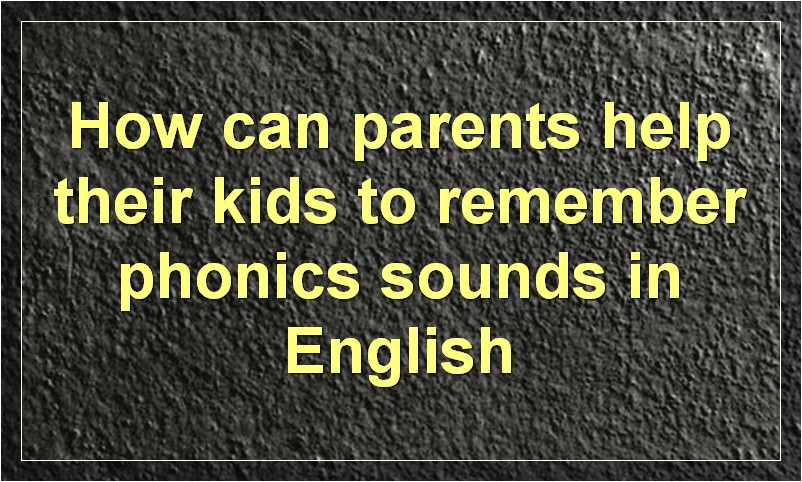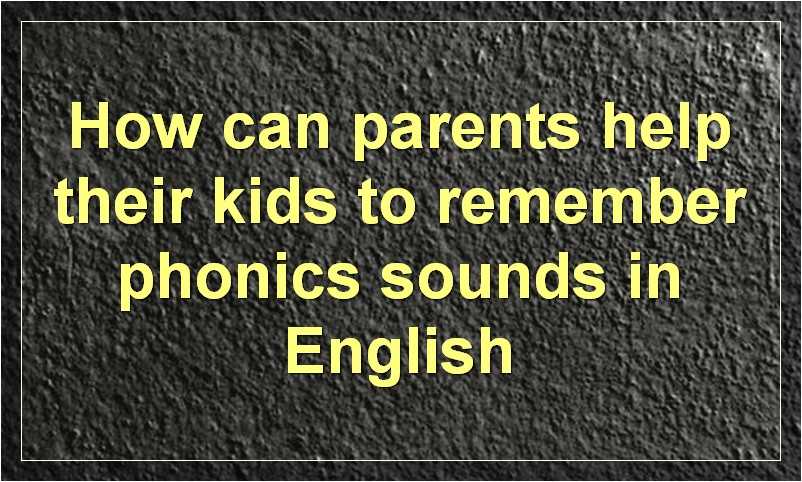In order to teach phonics sounds to kids, parents need to understand how the English language works. The English language is made up of 26 letters, which are each represented by a sound. In order to read and write words, children need to be able to identify these sounds and match them to the corresponding letter.
One of the best ways for parents to teach their kids phonics sounds is by using a method called synthetic phonics. Synthetic phonics involves teaching children to read by breaking words down into their individual sound units, or phonemes. By isolating and pronouncing these phonemes, children can learn to read words more effectively.
There are a number of different resources that parents can use to help teach their kids synthetic phonics. There are many excellent books and websites that provide materials and activities specifically designed to help children learn synthetic phonics. In addition, there are a number of apps that can be used to reinforce what children are learning.
When teaching synthetic phonics to kids, it is important to start with the most basic sounds and work up from there. The first step is usually to teach children the individual letter sounds. Once children have mastered these, they can then begin to blend these sounds together to read words.
It is also important to provide plenty of opportunities for practice. One way to do this is by reading aloud with your child on a regular basis. You can also have your child practice reading words and phrases aloud in front of you. Additionally, there are a number of online games and activities that can be used to help kids practice their new skills.
By taking the time to teach your kids phonics sounds, you will be helping them develop the important skills they need to become successful readers and writers.
What are some ways parents can teach their kids phonics sounds in English?
Parents can use a variety of methods to teach their kids phonics sounds in English. One way is to use letter tiles or flashcards to help kids learn the correct order of the alphabet and the corresponding sounds each letter makes. Another method is to use word families, where children learn groups of words that share a common sound or spelling pattern. Additionally, parents can have their kids read aloud from books that contain a lot of repetition and rhyming to help them notice sound patterns. Finally, parents can have their kids listen to audio recordings of stories to help them pick up on the different sounds in English.
How can parents help their kids to remember phonics sounds in English?

One way to help kids remember phonics sounds in English is to use a technique called “sound blending.” This involves saying the individual sounds that make up a word and then putting them all together to form the word. For example, if a child is trying to remember how to spell the word “cat,” you would say the sounds “c-a-t” and then have the child put them all together to form the word.
Another way to help kids remember phonics sounds in English is to use a technique called “sound isolation.” This involves breaking a word down into its individual sound units and then saying each one separately. For example, if a child is trying to remember how to spell the word “cat,” you would break it down into the sounds “c-a-t” and then say each sound separately.
There are many other techniques that parents can use to help their kids remember phonics sounds in English. Some of these include using flashcards, playing games, and making up songs or rhymes. Whatever technique you choose, make sure that you are consistent with it and that you praise your child when he or she makes progress.
What are some common mistakes that kids make when learning phonics sounds in English?
One common mistake that kids make when learning phonics sounds in English is not being able to distinguish between the different sounds of the letters. For example, the letter “b” can be pronounced like a “b” sound in words like “baby” or “ball”, but it can also be pronounced like a “v” sound in words like “vest” or “verb”. This can be confusing for kids who are just starting to learn phonics.
Another common mistake is not being able to correctly produce the sounds of the letters. This is often because kids are not familiar with the mouth positions needed to make certain sounds. For example, the “th” sound is made by putting your tongue between your teeth and blowing out air, which can be tricky for kids to master.
Finally, another common mistake is incorrectly blending sounds together when reading words. This can happen when kids try to read a word by sounding out each letter separately instead of blending the sounds together. For example, the word “cat” is made up of three separate sounds: “c-a-t”. If a child reads each sound individually, it will sound like they are saying “keh-ah-tee”, which is not how the word is actually pronounced.
How can parents tell if their kids are having trouble with phonics sounds in English?
There are a few telltale signs that parents can look out for if they suspect their child is having trouble with phonics sounds in English. One such sign is if the child has difficulty sounding out words when reading aloud. Another is if the child frequently guessing at words or skipping over words altogether when reading. If a child is displaying either of these behaviors, it may be indicative of trouble with phonics sounds and parents should consult with their child’s teacher or a tutor to get help.
What are some resources that parents can use to help their kids learn phonics sounds in English?
There are a number of resources that parents can use to help their kids learn phonics sounds in English. One resource is the Phonics for Parents website, which provides tips and tricks for teaching phonics to kids. Another resource is the Reading Rockets website, which offers a variety of articles and videos on teaching phonics to kids. Finally, the National Reading Panel report on effective reading instruction provides detailed information on how to teach phonics to kids.
How often should parents review phonics sounds with their kids?

Phonics sounds should be reviewed with kids on a daily basis in order for them to retain the information and progress in their reading skills.
What is the best time of day for parents to work on phonics sounds with their kids?
The best time of day for parents to work on phonics sounds with their kids is in the evening when the kids are tired and more likely to be receptive to learning.
What should parents do if their kids seem to be struggling with phonics sounds in English?
There are a few things that parents can do if their kids seem to be struggling with phonics sounds in English. The first thing is to make sure that the child is getting enough exposure to the language. This means speaking English at home as much as possible, reading books together, and watching shows and movies in English.
Another thing that parents can do is to help their child practice the sounds that they are having trouble with. There are a lot of great resources online and in libraries that can help with this. Finally, it is important to talk to the child’s teacher to get some ideas about what else can be done to help.
Is there anything parents should avoid doing when teaching their kids phonics sounds in English?
There are a few things to avoid when teaching your kids phonics sounds in English. First, try not to get overwhelmed yourself. There is a lot of information to cover, but you can take it one step at a time. Secondly, don’t get too caught up in the details. The main goal is for your child to be able to read and pronounce words correctly, not to master every single sound. Lastly, avoid using materials that are boring or confusing. There are plenty of great resources out there that can make learning phonics fun and engaging for both you and your child.
What are some tips that parents can follow to make teaching phonics sounds to their kids more effective?
When it comes to teaching phonics to kids, parents need to be patient, creative and consistent. Here are a few tips that can help make the learning process more effective:
1. Start with the basics – Before introducing your child to different letter sounds, make sure they are familiar with the alphabet. Once they know their ABCs, you can start teaching them basic letter-sound correspondence.
2. Make it fun – Phonics doesn’t have to be all work and no play. There are a number of games and activities that can make learning phonics fun for both you and your child.
3. Be consistent – It’s important to be consistent when teaching phonics so that your child doesn’t get confused. This means using the same method of instruction and providing ample practice opportunities.
4. Be patient – Learning phonics takes time and patience is key. If your child isn’t getting it right away, don’t get discouraged – keep at it and eventually they will catch on.




